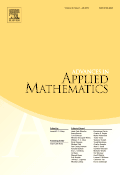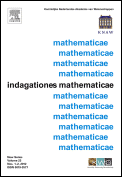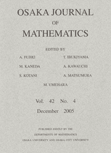
TAIWANESE JOURNAL OF MATHEMATICS
Scope & Guideline
Elevating research excellence in the heart of mathematics.
Introduction
Aims and Scopes
- Applied and Computational Mathematics:
Focusing on numerical methods, computational techniques, and applied mathematics, this area emphasizes the development and analysis of algorithms for solving mathematical problems arising in engineering, physics, and other sciences. - Pure Mathematics and Theoretical Research:
This includes research in algebra, geometry, topology, and analysis. The journal publishes papers that explore the fundamental properties and structures of mathematical objects. - Differential Equations and Dynamic Systems:
A core area of interest that covers ordinary and partial differential equations, dynamical systems, and their applications in modeling physical phenomena. - Mathematical Physics:
Research that intersects mathematics and physics, particularly in areas such as quantum mechanics, relativity, and statistical mechanics, is frequently featured. - Optimization and Control Theory:
This scope includes studies on optimization problems, variational methods, and control theory, highlighting both theoretical and practical aspects. - Graph Theory and Combinatorics:
The journal also emphasizes contributions in graph theory, combinatorial structures, and their applications in computer science and network analysis.
Trending and Emerging
- Fractional Calculus and Differential Equations:
There is a noticeable increase in papers related to fractional calculus, emphasizing its applications in various fields, including physics and engineering, indicating a growing interest in non-integer order derivatives. - Machine Learning and Data Science Applications:
Research that integrates mathematical theories with machine learning and data science is on the rise, showcasing innovative methodologies for data analysis, modeling, and optimization. - Nonlinear Dynamics and Chaos Theory:
The exploration of nonlinear dynamics and chaos in both theoretical and applied contexts is becoming more prominent, reflecting the complexity of modern systems. - Algebraic Geometry and Its Applications:
Algebraic geometry is witnessing renewed interest, particularly in its applications to coding theory, cryptography, and complex systems, indicating a shift towards interdisciplinary research. - Mathematical Biology and Epidemiology:
With the recent global focus on health, mathematical modeling in biology and epidemiology, particularly concerning disease dynamics, has gained significant traction.
Declining or Waning
- Classical Geometry:
Papers focusing on traditional topics in classical geometry, such as Euclidean and non-Euclidean geometries, have become less frequent, possibly due to the rise of more abstract and computational approaches. - Elementary Number Theory:
Research in elementary number theory seems to be waning, with fewer papers addressing classical problems or methods, as the field shifts towards more complex and computationally intensive areas. - Traditional Functional Analysis:
While still relevant, topics in traditional functional analysis may be receiving less attention, with a noticeable increase in interest towards more applied or interdisciplinary approaches. - Statistical Methods in Pure Mathematics:
The intersection of statistics with pure mathematics has seen a decline, as the focus shifts towards more application-driven statistical methodologies in real-world scenarios.
Similar Journals

Journal of Applied Mathematics and Computing
Exploring the Intersection of Theory and ApplicationThe Journal of Applied Mathematics and Computing, published by SPRINGER HEIDELBERG, is a premier open-access journal dedicated to the advancements and interdisciplinary applications of mathematical theory and computing techniques. Since its inception in 1997, this journal has become a vital resource for researchers and practitioners, contributing significantly to the fields of Applied Mathematics and Computational Mathematics, currently positioned in the Q2 category as per the 2023 metrics. With an impressive Scopus ranking of #130 out of 635 in Applied Mathematics and #48 out of 189 in Computational Mathematics, it reflects a robust academic influence and a dedication to high-quality research dissemination. The journal's accessibility as an open-access resource since 2002 ensures that its groundbreaking findings are available to a global audience, fostering collaboration and innovation in the mathematical sciences. Based in Heidelberg, Germany, the journal continues to invite contributions that push the boundaries of both theory and practical applications, making it an essential platform for scholars, professionals, and students alike.

ADVANCES IN APPLIED MATHEMATICS
Unlocking the Potential of Mathematics for TomorrowADVANCES IN APPLIED MATHEMATICS, published by ACADEMIC PRESS INC ELSEVIER SCIENCE, is a prestigious journal that has served the mathematical community since 1980. With its ISSN 0196-8858 and E-ISSN 1090-2074, the journal is based in the United States, specifically in San Diego, CA. As a leading periodical in the field, it holds a notable Q2 ranking in Applied Mathematics and has been consistently ranked in the 43rd percentile among similar journals, illustrating its relevance and impact within the discipline. Although not an Open Access journal, ADVANCES IN APPLIED MATHEMATICS plays a crucial role in disseminating significant research findings, theoretical studies, and innovative applications of mathematics that address real-world problems. Researchers, professionals, and students alike will find valuable insights in its carefully curated publications, making it an essential resource for those looking to advance their understanding and application of mathematics.

INDAGATIONES MATHEMATICAE-NEW SERIES
Exploring the depths of theory and application in mathematics.INDAGATIONES MATHEMATICAE-NEW SERIES is a distinguished academic journal specializing in the field of mathematics, with a focus on both theoretical and applied aspects of the discipline. Published by Elsevier, a leading publisher in the scientific community, this journal has established itself as a crucial platform for the dissemination of high-quality research. With an ISSN of 0019-3577 and an E-ISSN of 1872-6100, it operates out of the Netherlands and has been a vital resource for academics since its inception in 1969. Currently, it holds a Q2 ranking in the mathematics category, signifying its relevance and impact in the field, with a Scopus rank of #222 out of 399 in General Mathematics, placing it in the 44th percentile. Although it does not currently offer Open Access options, INDAGATIONES MATHEMATICAE-NEW SERIES is committed to contributing to the advancement of mathematics by publishing original research articles, reviews, and notes that enrich the academic community. Researchers, students, and professionals alike will find invaluable insights and developments within its pages, making it a cornerstone journal for those keen on exploring the complexities of mathematics.

Journal of Mathematics Mechanics and Computer Science
Empowering researchers with open access to cutting-edge discoveries.Journal of Mathematics Mechanics and Computer Science is a pioneering open access journal published by AL-FARABI KAZAKH NATL UNIV, dedicated to advancing the field of mathematics and its applications in mechanics and computer science. Established in 2009, this journal aims to provide a platform for innovative research, encouraging the dissemination of high-quality, peer-reviewed articles that push the boundaries of mathematical theory and computational methods. Though the journal currently ranks within the lower quartiles in Scopus categories, it remains committed to fostering academic discourse and advancing knowledge in its scope areas. Located in Almaty, Kazakhstan, the journal also emphasizes accessibility, ensuring that all research is readily available to researchers, professionals, and students worldwide. With a focus on developing new theoretical frameworks and practical applications, the Journal of Mathematics Mechanics and Computer Science is an essential resource for those aiming to engage with cutting-edge developments in mathematics and computer science.

Italian Journal of Pure and Applied Mathematics
Bridging Theory and Application in MathematicsThe Italian Journal of Pure and Applied Mathematics, published by FORUM EDITRICE UNIV UDINESE, is an esteemed platform dedicated to the dissemination of high-quality research within the field of mathematics. With an ISSN of 1126-8042 and an E-ISSN of 2239-0227, this journal serves as a crucial resource for mathematicians seeking to contribute to current discussions and advancements in both pure and applied mathematical sciences. Although the journal currently holds a quartile rank of Q4 in the field of miscellaneous mathematics and is positioned within the 10th percentile of Scopus rankings, it remains committed to fostering valuable academic discourse. This journal particularly welcomes submissions that explore innovative mathematical theories and methodologies, offering a unique insight into the diverse aspects of mathematical research. Operating under a traditional access model, it provides a gateway for researchers, professionals, and students to deepen their understanding and expand their contributions to the mathematical community. With coverage spanning from 2010 to 2024, the journal continues to enhance its reputation as a reliable source of contemporary mathematical scholarship.

Communications in Mathematical Sciences
Connecting Scholars Through Groundbreaking MathematicsCommunications in Mathematical Sciences is a prestigious journal published by INT PRESS BOSTON, INC, dedicated to advancing the field of mathematical sciences through the dissemination of high-quality research. Since its inception in 2003, the journal has established itself as a key platform for scholars in both applied and theoretical mathematics, evidenced by its impressive rankings, with a Q2 designation in Applied Mathematics and a Q1 status in Miscellaneous Mathematics categories as of 2023. Although not an open-access journal, it provides comprehensive access to groundbreaking studies that span a wide array of topics within mathematical sciences, making it invaluable for researchers, professionals, and students alike. The journal's strong performance metrics, including a Scopus rank that places it in the 64th and 38th percentiles for General and Applied Mathematics, respectively, highlight its influence and significance within the academic community. With an optimistic convergence towards future advancements by 2024, Communications in Mathematical Sciences continues to play a vital role in the growth and evolution of mathematical inquiry.

CANADIAN JOURNAL OF MATHEMATICS-JOURNAL CANADIEN DE MATHEMATIQUES
Unveiling the complexities of mathematics for a brighter future.Canadian Journal of Mathematics - Journal Canadien de Mathématiques is a prestigious peer-reviewed journal published by Cambridge University Press, which aims to advance the field of mathematics through the dissemination of high-quality research articles. With its ISSN 0008-414X and E-ISSN 1496-4279, the journal plays a pivotal role in fostering mathematical research and collaboration. It has been recognized for its impactful contributions, currently holding a category quartile ranking of Q2 in Mathematics (miscellaneous) for 2023 and sits in the 66th percentile among its peers according to Scopus rankings. As the journal continues its convergence from its inception in 1994 through to 2024, it remains a vital resource for researchers, professionals, and students seeking to stay at the forefront of mathematical developments. The journal does not operate under an open access model, allowing for a curated collection of articles that adhere to rigorous academic standards.

Proceedings of the Steklov Institute of Mathematics
Championing Quality Research in the Mathematical RealmProceedings of the Steklov Institute of Mathematics is a reputable journal published by MAIK NAUKA/INTERPERIODICA/SPRINGER, specializing in the diverse and dynamic field of mathematics. With an ISSN of 0081-5438 and an E-ISSN of 1531-8605, this journal serves as a vital platform for disseminating high-quality research, particularly in the area of miscellaneous mathematics. The journal's standing is reflected in its placement in Q3 of the 2023 Mathematics category, ranking 61st out of 90 in Scopus, placing it in the 32nd percentile among its peers. Spanning a convergence period from 2006 to 2024, the Proceedings of the Steklov Institute of Mathematics aims to foster scholarly dialogue and advance mathematical research, making it essential reading for researchers, professionals, and students looking to stay at the forefront of mathematical innovation.

Bulletin of the Iranian Mathematical Society
Connecting theory and practice in the world of mathematics.The Bulletin of the Iranian Mathematical Society, published by SPRINGER SINGAPORE PTE LTD, is a distinguished journal dedicated to advancing the field of mathematics. With an ISSN of 1017-060X and E-ISSN 1735-8515, this journal has established a valuable platform for researchers and scholars to disseminate their findings from 2008 to 2024. The journal is categorized in the Q2 tier of Mathematics (miscellaneous) for 2023, showcasing its importance and relevance in the mathematical community, ranked #169 out of 399 in General Mathematics with a 57th percentile standing in Scopus. While currently operating under a subscription model, it remains an essential resource for professionals and students seeking cutting-edge research and developments in various domains of mathematics. The Bulletin aims to bridge theoretical research and practical application, thereby enriching both academia and industry.

OSAKA JOURNAL OF MATHEMATICS
Fostering Global Dialogue in Mathematical ScholarshipOSAKA JOURNAL OF MATHEMATICS, established in 1949 and published from Japan, stands as a reputable platform dedicated to advancing the field of mathematics. With an ISSN of 0030-6126, this journal showcases research in various mathematical disciplines, contributing significantly to both theoretical and applied mathematics. Though it currently holds a Q3 designation in the miscellaneous mathematics category, the journal aims to enhance its impact and visibility within the academic community. Researchers can benefit from the latest insights and findings, making it an essential read for anyone involved in mathematical studies. The journal emphasizes quality over quantity, providing a selective peer-reviewed process that ensures rigorous academic standards. Furthermore, while it is not an open-access journal, it maintains a commitment to disseminating valuable mathematical knowledge across the globe, serving the scholarly community through traditional subscription-based access. OSAKA JOURNAL OF MATHEMATICS is an invaluable resource for professionals, researchers, and students seeking to stay at the forefront of mathematical research and discussions.